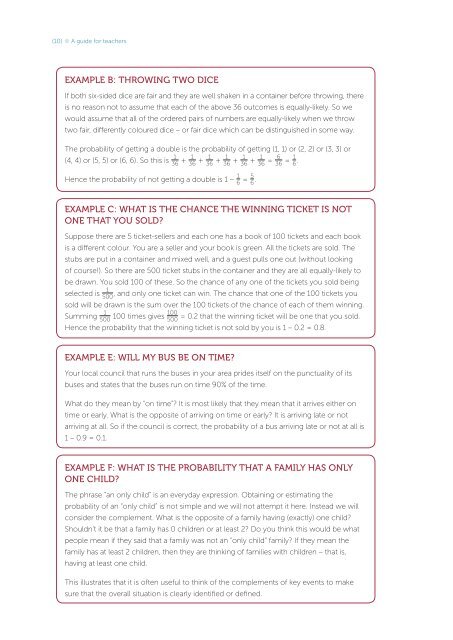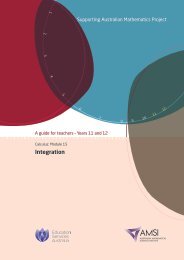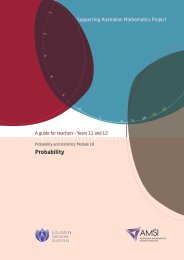PDF Version of module - the Australian Mathematical Sciences ...
PDF Version of module - the Australian Mathematical Sciences ...
PDF Version of module - the Australian Mathematical Sciences ...
You also want an ePaper? Increase the reach of your titles
YUMPU automatically turns print PDFs into web optimized ePapers that Google loves.
{10} A guide for teachersEXAMPLE B: THROWING TWO DICEIf both six-sided dice are fair and <strong>the</strong>y are well shaken in a container before throwing, <strong>the</strong>reis no reason not to assume that each <strong>of</strong> <strong>the</strong> above 36 outcomes is equally-likely. So wewould assume that all <strong>of</strong> <strong>the</strong> ordered pairs <strong>of</strong> numbers are equally-likely when we throwtwo fair, differently coloured dice – or fair dice which can be distinguished in some way.The probability <strong>of</strong> getting a double is <strong>the</strong> probability <strong>of</strong> getting (1, 1) or (2, 2) or (3, 3) or(4, 4) or (5, 5) or (6, 6). So this is 136 + 136 + 136 + 136 + 136 + 136 = 6 36 = 1 6 .Hence <strong>the</strong> probability <strong>of</strong> not getting a double is 1 – 1 6 = 5 6 .EXAMPLE C: WHAT IS THE CHANCE THE WINNING TICKET IS NOTONE THAT YOU SOLD?Suppose <strong>the</strong>re are 5 ticket-sellers and each one has a book <strong>of</strong> 100 tickets and each bookis a different colour. You are a seller and your book is green. All <strong>the</strong> tickets are sold. Thestubs are put in a container and mixed well, and a guest pulls one out (without looking<strong>of</strong> course!). So <strong>the</strong>re are 500 ticket stubs in <strong>the</strong> container and <strong>the</strong>y are all equally-likely tobe drawn. You sold 100 <strong>of</strong> <strong>the</strong>se. So <strong>the</strong> chance <strong>of</strong> any one <strong>of</strong> <strong>the</strong> tickets you sold being1selected is 500 , and only one ticket can win. The chance that one <strong>of</strong> <strong>the</strong> 100 tickets yousold will be drawn is <strong>the</strong> sum over <strong>the</strong> 100 tickets <strong>of</strong> <strong>the</strong> chance <strong>of</strong> each <strong>of</strong> <strong>the</strong>m winning.1100Summing 500 100 times gives 500 = 0.2 that <strong>the</strong> winning ticket will be one that you sold.Hence <strong>the</strong> probability that <strong>the</strong> winning ticket is not sold by you is 1 – 0.2 = 0.8.EXAMPLE E: WILL MY BUS BE ON TIME?Your local council that runs <strong>the</strong> buses in your area prides itself on <strong>the</strong> punctuality <strong>of</strong> itsbuses and states that <strong>the</strong> buses run on time 90% <strong>of</strong> <strong>the</strong> time.What do <strong>the</strong>y mean by “on time”? It is most likely that <strong>the</strong>y mean that it arrives ei<strong>the</strong>r ontime or early. What is <strong>the</strong> opposite <strong>of</strong> arriving on time or early? It is arriving late or notarriving at all. So if <strong>the</strong> council is correct, <strong>the</strong> probability <strong>of</strong> a bus arriving late or not at all is1 – 0.9 = 0.1.EXAMPLE F: WHAT IS THE PROBABILITY THAT A FAMILY HAS ONLYONE CHILD?The phrase “an only child” is an everyday expression. Obtaining or estimating <strong>the</strong>probability <strong>of</strong> an “only child” is not simple and we will not attempt it here. Instead we willconsider <strong>the</strong> complement. What is <strong>the</strong> opposite <strong>of</strong> a family having (exactly) one child?Shouldn’t it be that a family has 0 children or at least 2? Do you think this would be whatpeople mean if <strong>the</strong>y said that a family was not an “only child” family? If <strong>the</strong>y mean <strong>the</strong>family has at least 2 children, <strong>the</strong>n <strong>the</strong>y are thinking <strong>of</strong> families with children – that is,having at least one child.This illustrates that it is <strong>of</strong>ten useful to think <strong>of</strong> <strong>the</strong> complements <strong>of</strong> key events to makesure that <strong>the</strong> overall situation is clearly identified or defined.
















